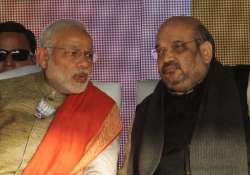36 years of BJP: A journey from ‘Atal-Advani’ to ‘Modi-Shah’ era
Today, a new generation has taken over the mantle and instead of ‘Atal-Advani’, the new buzz word in the party is ‘Modi-shah’.

New Delhi: It was on this day (April 6) in 1980 that the Bharatiya Janata Party (BJP) was founded with Atal Bihari Vajpayee as its first President.
Technically, the new party was a breakaway faction of the Janata Party (JP) and consisted of leaders belonging to the erstwhile Bhartiya Jana Sangh (BJS). BJS had merged with the Janata Party just before 1977 general elections. The merger was necessitated in the aftermath of the then Prime Minister Indira Gandhi imposing Emergency in June 1975.
The atrocities committed during Emergency forced all major opposition parties to join hands to defeat the dictatorial Congress government under the leadership of Indira Gandhi and her aggressive son Sanjay Gandhi.
The urgency to dethrone Indira Gandhi forced political leaders subscribing to divergent and sometimes diagonally opposite ideologies to forget their differences and take on Indira-led Congress together under the inspiring leadership of Jay Prakash Narayan.
The strategy worked to the perfection and the Janata Party conglomerate overthrew Indira Gandhi-led Congress in 1977 general elections.
The top leadership of Bharatiya jan Sangh (BJS) mainly consisted of people who came from RSS background. In fact, BJS was seen as the political arm of RSS.
Since Janata Party had many constituents with leaders having pathological hatred for RSS on ideological grounds, their discomfort in sharing the dais with BJS leaders was coming to the fore with each passing day. Raising strong objections over ‘dual membership’, they asked those with BJS background to break their relations with RSS.
After Indira Gandhi made a comeback in 1980 following mid-term elections in the aftermath of untimely collapse of Janata Party government owing to shenanigans of Congress, the fissures among different factions of Janata Party became more apparent.
Under these circumstances, those belonging to erstwhile BJS decided to break away from Janata Party and they formed a new political entity called Bharatiya Janata Party (BJP) under the leadership-duo of Atal Bihari Vajpayee and Lal Krishna Advani.
In the first general election that the BJP contested, the party fared disastrously and could manage to win only two seats in 1984 Lok Sabha elections. Since 1984 general elections was held in the backdrop of the assassination of Prime Minister Indira Gandhi, there was a massive sympathy wave blowing in favour of her son Rajiv Gandhi who was leading the Congress party in Lok Sabha elections. The intensity of sympathy wave was so strong that BJP President Vajpayee himself lost the elections against Congress leader Madhav Rao Scindia from Gwalior Lok Sabha constituency.
In 1989 Lok Sabha elections, the party once again aligned with VP Singh led Janata Dal to dethrone Rajiv Gandhi and the alliance succeeded in defeating the Congress party which had to pay a heavey price after being tainted in Bofors scandal.
However, the BJP withdrew support from V P Singh after Advani’s historic Rath-Yatra to garner support for construction of Ram Temple in Ayodhya was stopped in Bihar by Chief Minister Lalu Prasad Yadav.
In 1991 general elections, the party, for the first time, crossed 100 mark and actually won 120 seats riding on the Ram temple movement. Here onwards, there was no looking back for the party.
From 1998-2004, the party led NDA alliance ruled at the centre under the prime ministership of Atal Bihari Vajpayee. The NDA lost power to Congress-led in 2004.
In 2009, the NDA with Advani as PM candidate lost once again to Congress-led UPA and with this the Atal-Advani era in BJP virtually came to an end after a glorious 29 years.
Right after the defeat in 2009 Lok Sabha elections, the BJP cadre started looking for an alternative face who could catapult the party to power at the centre.
The party cadre forced Advani to make way for the more charismatic Narendra Modi as PM candidate in 2014 general elections . Narendra Modi, by then, had successfully ruled Gujarat for 12 years and a restless party cadre rallied behind him.
Narendra Modi put his heart out in the election campaign and created history by winning a historic 282 seats for his party. After 30 years, any single political party got the mandate to rule Delhi on its own.
After taking over as the Prime Minister Narendra Modi got his close confidante Amit Shah appointed as the BJP chief. Shah was rewarded for delivering an unprecedented 73 Lok Sabha seats from UP, the state which he was made in-charge of.
36 years ago, when the BJP was formed, it was known as the party of Atal and Advani. Today, a new generation has taken over the mantle and instead of ‘Atal-Advani’, the new buzz word in the party is ‘Modi-shah’. The transition is complete and the cadre is rejoicing.